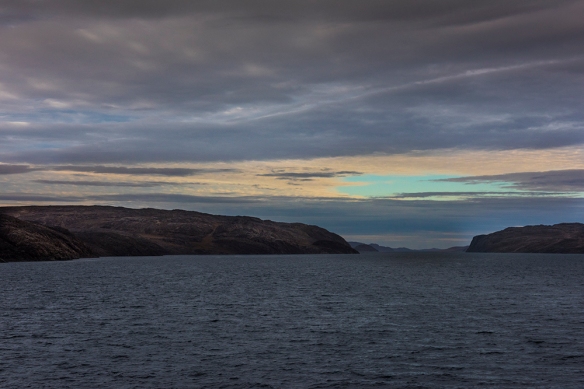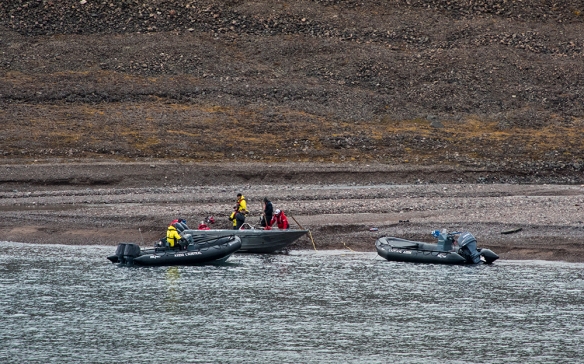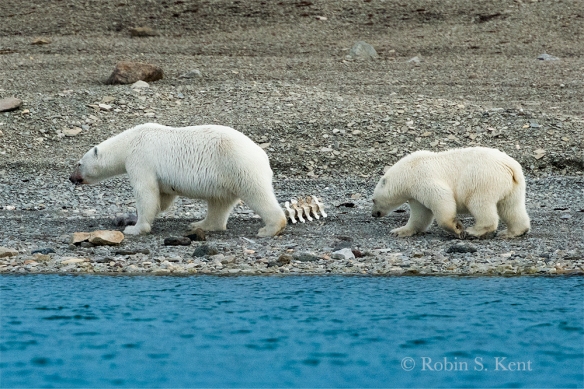Departing Fort Ross, we entered Bellot Strait, a narrow channel that would take us into Peel Sound where we would resume tracking the route of John Franklin’s ill-fated expedition and learn more about his extraordinary wife, Lady Jane Franklin, and her unceasing efforts to galvanize the British public, the British Government, and many others on behalf of her missing husband.

Bellot Strait with the northernmost tip of the North American continent on the left
Bellot Strait, separating Somerset Island from the Boothia Peninsula (see map below), is named after Joseph Rene Bellot, a young French naval officer who offered his services to Lady Jane Franklin to serve on a rescue mission that she was personally organizing. (For a detailed English account of Bellot’s Arctic experiences, consult this article. For French speakers wishing a more complete exposition, obtain a copy of the book by Nadine and Jean-Claude Forestier-Blazart.)

Sunset, Peel Sound, after exiting Bellot Strait
On Bellot’s first trip, as second in command, he discovered what others had missed, the strait that now bears his name and the key to one variant in the routes through the Northwest Passage. But the expedition failed to find any trace of Franklin, largely because the ship’s captain ignored Bellot’s advice to head south. Had they done so, they likely would have found the evidence discovered by others 7 years later. Bellot’s habit of volunteering for the most dangerous tasks led to his death on his second voyage in 1853. He offered to lead a small group on a dangerous trip through a treacherous stretch of sea ice to deliver dispatches to another ship. On the third night, he fell into the freezing water and disappeared.
On our own voyage, we were beginning to learn that it was impossible to predict what would happen on any given day. The next morning started early with a 7:00 AM encounter with several pods of beluga whales close to the shore of a narrow inlet.

Pod of Beluga Whales
A little later we would have our own encounter with an abandoned vessel, albeit one of little historical consequence . A 21-foot runabout with forward console and twin outboards was spotted upside down on the shore of a small bay. Several storage containers were scattered along the shore as well. Two Zodiacs were sent out to investigate while a pod of Beluga whales cavorted in the shallow waters about 700 yards away.

Recovery Team Assessing Abandoned Boat
The recovery team prepared the mystery boat for loading it aboard and transporting it to the next village while the ship’s naturalists and photographer hiked down to get a close look at the Belugas.

Nathalie Michel, ship photographer (in red), gets close to the belugas
My photograph (above) using Nikon D810 with 70-200mm with 1.7 extender eqiuvalent to 340mm.

Beluga Whale with Calf
Nathalie’s photograph above, using Nikon D4s with 80-400mm telephoto at 80mm (there’s a lesson here–get close when you can).
Later, we rode zodiacs into a different bay to observe a number of polar bears picking over the skeletal remains of Beluga whales on the shore. Live Belugas moved contentedly through the shallow waters seemingly oblivious to the fate of their relatives on the shore.

Polar Bear with Cub
At day’s end, with the recovered boat securely lashed down on the foredeck, we headed south in the direction that Lady Franklin repeatedly implored the leaders of search expeditions to explore. She, like Bellot, was ignored by almost all of them, who seemed to think other routes held more promise. (Canadian author Ken McGoogan has written the best book about her, “Lady Franklin’s Revenge.”) She, more than any other person, was responsible for sparking the massive search effort as well as Franklin’s legacy.

(From James P. Delgado, Across the Top of the World, 1999, p.113)
We were heading toward the area where one of Franklin’s two ships was found in 2014, (red arrow in map above) although the specific underwater location has not been revealed, apparently to preserve its integrity. We did know, however, that an active search was currently underway to find the second ship. So far, no results had been reported although the summer window for underwater surveys would soon be ending.
Next: The Mystery of Franklin’s Disappearance Solved (mostly)….

So beautiful…bears are amazing ☺️
LikeLiked by 1 person
Thanks very much. Yes, they are impressive animals. It was always a treat to see them in their element.
LikeLiked by 1 person
for sure free is best! have a wonderful photographing Robin…beautiful posts 🙂
LikeLiked by 1 person
I like the combination of history with current experience! Amazing those polar bears with the skeletal remains. That’s not something one sees every day. I’m enjoying this trip without the seasickness. 😉
LikeLiked by 1 person
Thanks, Laura. I’m glad the historical background is of interest. We did a fair amount of research in advance plus the history specialist on board provided a lot of additional narrative. In the dim twillight of morning before the passengers appeared on deck and the sun was just below the horizon, one could almost channel back to the ghosts of those who came before us.
LikeLiked by 1 person
Oh I just got chills! We are taking a Danube river cruise next September and I plan on getting some history under my belt before we leave. I hope I can portray our visit as you did.
LikeLiked by 1 person
What an incredible journey and excellent photos by both you and Nathalie.
LikeLiked by 1 person
Thanks very much. Nathalie, as the ship’s professional photographer, has exceptional talent as does her husband Frederic who was the ship’s videographer. As would be expected they occasionally had access to positions not available to passengers such as this unscheduled stop on the beach. But she was quite generous, giving me permission to usesome of her images in this blog if they would help make a point. I thought this was a good occasion to use one of them.
LikeLiked by 1 person
Hi Robin, thanks for sending me the link to your blog. I finally catch up to episode 8 (latest so far). I’m in awe of your exquisite photography and description of this voyage. It has brought back so much fond vivid memory of every thing we saw and every moment we shared with you and your wife along the way, You make understanding the complex history and events of the early Arctic explorers seemingly so easily comprehensible. Bravo.
I cannot wait to read the next episode.
Best wishes for your upcoming Open Studio event.
Karen ( your fellow cruise mate from Australia)
PS I’m nit a WordPress blogger and member but am so happy I can leave my thoughts here.
LikeLiked by 1 person
Dear Robin,
I left a comment here earlier on today but I cannot find it here. Maybe because I’m not a WordPress member.
Just to quickly repeat what I meant to say: I am absolutely in awe of your exquisite photos and the simple-to-comprehend recount of the complex history of the early Arctic exploration. Your blog brings back the fondest memory of everything we saw and moments we shared with you and your wife during the voyage.
I can’t wait to read the next episode.
Best wishes for the upcoming Open Studio event
Karen (your fellow passenger from Australia)
LikeLiked by 1 person
Hi, Karen,
Thanks for your comments, good to hear from you and I’m glad you like the blog. It was great meeting you and Tony on the journey. Sorry for the delay in getting your comments cleared. WordPress holds back any new people (who are not already WordPress members) until the author checks the comments. After the first time through, you should be OK in the future.
LikeLike
Hi Robin, I can see both of my left comments now. A bit embarrassing indeed, as I am not a blogger: don’t know the drill. yes, shall look forward to your next episode #9.
LikeLiked by 1 person
Such an amazing journey so far. Love the whales!
LikeLiked by 1 person
Yes, the Beluga whales are very strange. The Narwhals are stranger still, sometimes called the unicorn of the sea. We saw many but they are very hard to photograph well.
LikeLike
When my son told me about Narwhals I thought he was kidding me. They are so cool
LikeLiked by 1 person
What an amazing journey, Robin!
LikeLike